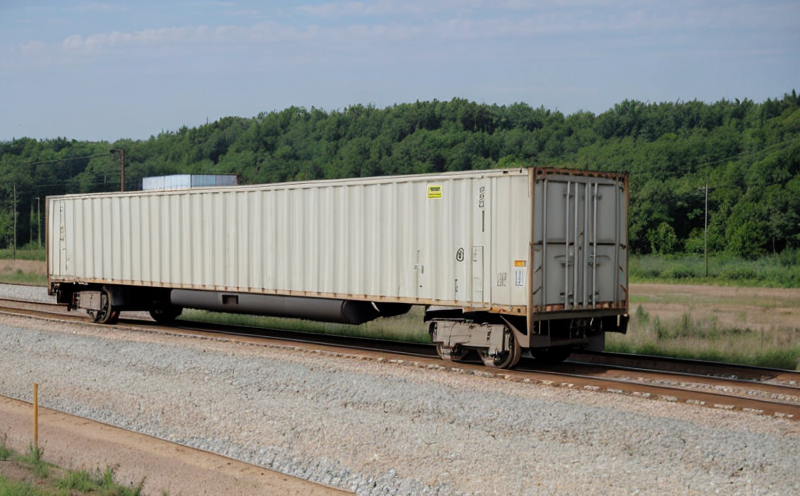EN 61373 Shock and Vibration Testing of Freight Wagon Equipment
The EN 61373 standard is a crucial guideline for ensuring the robustness, reliability, and safety of freight wagon equipment in railway transport. This test evaluates how components perform under shock and vibration loads that they are likely to encounter during operation. Compliance with this standard is essential for manufacturers aiming to meet international quality benchmarks.
The EN 61373 test focuses on the mechanical integrity of freight wagon equipment, including frames, bogies, couplings, and other critical components. It simulates real-world conditions that can subject these parts to extreme shock forces and vibrations. The standard is particularly relevant in railway environments where heavy loads are frequently transported over diverse terrains.
Shock and vibration testing plays a vital role in ensuring the durability of freight wagon equipment. These tests help identify potential weaknesses or design flaws early in the development process, allowing manufacturers to make necessary adjustments before full-scale production begins. By adhering to EN 61373, companies can demonstrate their commitment to quality and safety standards, thereby enhancing their reputation within the industry.
The test procedures outlined in EN 61373 are designed to simulate various environmental stresses that freight wagon equipment might face during its operational life cycle. This includes exposure to harsh weather conditions, rough tracks, and heavy loads. The standard provides detailed instructions for setting up tests using appropriate shock and vibration generators, ensuring accurate results.
Compliance with EN 61373 is not just about meeting regulatory requirements; it also contributes significantly to the overall performance and longevity of freight wagon equipment. By subjecting components to controlled shock and vibration environments, manufacturers can assess their resistance to damage caused by external factors like collisions or terrain variations.
For quality managers and compliance officers responsible for ensuring that products meet stringent international standards, EN 61373 offers a robust framework for validating the durability of freight wagon equipment. This standard ensures consistent performance across different models and batches, providing peace of mind regarding product reliability.
R&D engineers involved in developing new freight wagon designs will find EN 61373 particularly useful as it provides guidance on simulating realistic operating conditions early in the design phase. Early identification of any issues through rigorous testing helps streamline production processes while minimizing potential risks associated with unforeseen failures during operations.
Finally, procurement teams looking to source high-quality components can leverage EN 61373 when specifying supplier requirements or evaluating bids from various vendors. Ensuring that suppliers comply with this standard demonstrates a commitment to quality and safety throughout the supply chain.
Scope and Methodology
| Test Parameters | Description |
|---|---|
| Shock Load | Simulated using a drop hammer or similar device to apply controlled impacts. |
| Vibration Frequency Range | Determined based on the specific application, typically between 10 Hz and 250 Hz. |
| Duration of Exposure | Dependent on the type of equipment being tested but generally ranges from several seconds to minutes. |
| Data Collection | Involves monitoring displacement, acceleration, and force during testing. |
The methodology for EN 61373 shock and vibration testing involves subjecting the freight wagon equipment or its components to precisely controlled shock and vibration environments. The test setup typically includes a shaker table capable of generating specified frequency ranges and amplitudes. During the test, sensors measure various parameters such as displacement, acceleration, and force experienced by the specimen.
After each exposure period, detailed data analysis is conducted to evaluate whether the equipment meets predefined acceptance criteria. These criteria are based on industry standards like EN 61373 but may vary depending on specific application requirements. Compliance with these criteria ensures that the equipment can withstand the expected environmental stresses without sustaining significant damage.
Why Choose This Test
- Ensures compliance with international standards such as EN 61373.
- Provides confidence in the durability and reliability of freight wagon equipment.
- Aids in early detection of potential design flaws or material weaknesses.
- Supports quality assurance programs by providing objective data for decision-making.
- Facilitates consistent performance across different batches or models of equipment.
- Promotes safer operations by minimizing the risk of unexpected failures during service.
- Enhances reputation among clients and stakeholders through adherence to high-quality standards.
Choosing EN 61373 shock and vibration testing offers numerous benefits beyond mere compliance. It allows manufacturers to proactively address potential issues before they become critical problems, ensuring that their products meet the highest levels of safety and performance expectations.
Competitive Advantage and Market Impact
The implementation of EN 61373 shock and vibration testing provides significant competitive advantages for manufacturers in the railway and transportation sector. By demonstrating a commitment to quality through rigorous testing, companies can differentiate themselves from competitors who may not adhere strictly to such standards.
Compliance with this standard also enhances market reputation, making it easier for firms to secure contracts and gain customer trust. This is especially important given increasing demands for safety and reliability in modern transportation systems.
In addition to these benefits, successful completion of EN 61373 tests can lead to improved product longevity and reduced maintenance costs over the equipment’s lifespan. These advantages contribute positively towards cost-effectiveness, which is crucial in highly competitive markets.





